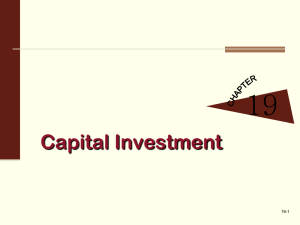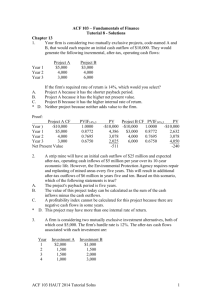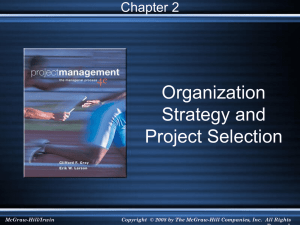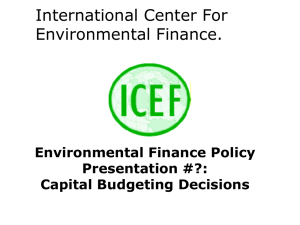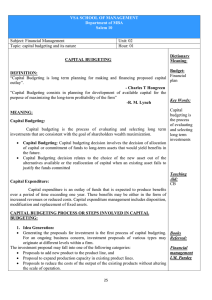ch02A
advertisement
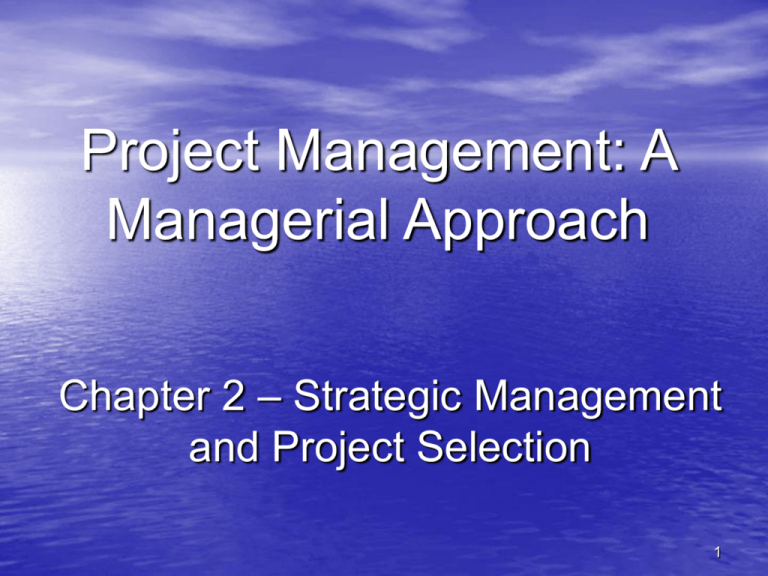
Project Management: A Managerial Approach Chapter 2 – Strategic Management and Project Selection 1 Overview • Project Selection and Criteria • Project Selection Models • Uncertainty and Risk • Information for Project Selection • Project Portfolio Process (PPP) • Project Proposals 2 Project Maturity and Reality • Many projects fall outside company mission • Projects without organizational goal/objective “fit” • Project budgets not tied to cost-benefit analysis 3 Multiple Project Management Issues • Delays in one project impacting others – Resource conflicts – Technology dependencies • Lack of resource “smoothing” – Peaks and valleys of resource utilization • Bottlenecks with scarce resources – Lack of workarounds 4 Project Selection • Evaluation process -- individual projects or groups of projects • Choosing some set of project options • Organizational objectives achieved • Managers use decision-aiding models • Models represent the problem’s structure • Aid in evaluating risks and options 5 Criteria for Project Selection Models • Realism - reality of manager’s decision • Capability- able to simulate different scenarios and optimize the decision • Flexibility - provide valid results within the range of conditions • Ease of Use - reasonably convenient, easy execution, and easily understood • Cost - Data gathering and modeling costs should be low relative to the cost of the project • Easy Computerization - must be easy and convenient to gather, store and manipulate data in the model 6 Nature of Project Selection Models – 2 Basic Types of Models • Numeric • Non-numeric – Two Critical Facts: • Models do not make decisions - People do! • All models are only partial representations of reality 7 Non-Numeric Models • Sacred Cow - project is suggested by a senior and powerful official in the organization • Operating Necessity - the project is required to keep the system running • Competitive Necessity - project is necessary to sustain a competitive position • Product Line Extension - projects are judged on how they fit with current product line, fill a gap, strengthen a weak link, or extend the line in a new desirable way. • Comparative Benefit Model - several projects are considered and the one with the most benefit to the firm is selected 8 Q-Sort – A Comparative Benefit Technique • • • • • • • Usually undertaken by a selection committee Project descriptions on separate cards Divide into high and low benefit groups Form a medium benefit/priority group from a selection of high and low projects Subdivide remaining high level projects into very high priority and high priority Repeat subdivision for low level projects Review the ranking for appropriateness and consistency 9 Q-Sort Project Selection 10 Numeric Models: Profit/Profitability – Payback period - initial fixed investment/estimated annual cash inflows from the project – Average Rate of Return - average annual profit/average investment – Discounted Cash Flow - Present Value Method – Internal Rate of Return - Finds rate of return that equates present value of inflows and outflows – Profitability Index - NPV of all future expected cash flows/initial cash investment 11 Financial Selection Criteria • Payback Model – Time to recover project investment • Investment €/Annual Net Savings = PB – Widely used – Emphasis on Cash Flow • Net Present Value (NPV) – Desired rate of return • (Est. Annual Cash Flow/Project Cost) X 100 = RoR – Compare “RoR” of project(s) to “target” 12 Payback Period • Estimated project costs: €100,000 • Annual cash inflows: €25,000 • Payback period: €100,000/€25,000 = 4 yr • Rapid payback reduces risk to the firm 13 Average Rate of Return • Emphasises the annual profitability of the project investment • Annual profits: €15,000 • Average Rate of Return: €15,000/€100,000 = 0.15 (15%) • Simple but ignores impact of inflation or cost of finance 14 Net Present Value (NPV) • Also known as Discounted Cash Flow (DCF) • NPV discounts the value of future returns by • • • taking into account the predicted inflation rate pi for each period i Initial investment Io is a negative cash flow NPV = Io + Σ Fi / (1 + pi)i Fi is the cash inflow in the period i 15 NPV Example with IIR • A required Internal Rate of Return (IRR), k, may • • • • be incorporated in an NPV determination NPV = Io + Σ Fi / (1 + k + pi)i €100,000 investment predicted to produce a net cash inflow of €25,000 pa for period of 8 years with pi = 3% pa and k = 15% NPV = - €100,000 + Σ €25,000 / (1 + 0.15 + 0.03i)I = + €1,939 Since this figure is positive the project meets the financial requirement for selection 16 Internal Rate of Return (IRR) and Profitability Index (PI) • Given a set of expected cash inflows and • • outflows for a project, the IRR is the discount rate that equates the present values of the two sets of flows. The value of IIR may be determined by trial and error or using (say) Excel The Profitability Index is the NPV of all future cash inflows divided by the initial cash investment – if PI > 1 the project may be accepted 17 Numeric Models: Scoring • Unweighted 0-1 Factor Model • Unweighted Factor Scoring Model • Weighted Factor Scoring Model • Constrained Weighted Factor Scoring Model • Goal Programming with Multiple Objectives Chapter 2-6 18 Risk Versus Uncertainty • Analysis Under Uncertainty - The Management of Risk – The difference between risk and uncertainty • Risk - when the decision maker knows the probability of each and every state of nature and thus each and every outcome. An expected value of each alternative action can be determined • Uncertainty - when a decision maker has information that is not complete and therefore cannot determine the expected value of each alternative 19 Risk Analysis • Principal contribution of risk analysis is to focus the attention on understanding the nature and extent of the uncertainty associated with some variables used in a decision making process • Usually understood to use financial measures in determining the desirability of an investment project 20 Risk Analysis • Probability distributions are determined or • • subjectively estimated for each of the “uncertain” variables The probability distribution for the rate of return (or net present value) is then found by simulation Both the expectation and its variability are important criteria in the evaluation of a project 21 Risk Analysis 22 Aggregate Project Planning 23 Project Portfolio Process - Purpose • Identify Projects that Meet Strategic Needs – Support Multiple Goals – Direct Organizational Improvement – Enhance/Enable Key Areas • Prioritize Potential Projects – Limit Active Projects to Manageable Level – Identify Risk-intensive Efforts – Balance Short, Medium, Long-term Returns • Reduce Projects from Getting in via “Backdoor” 24 Project Portfolio Process - Steps 1. Establish a Project Management “Governance” Structure – Senior Leaders and Technical Experts – Tied to Strategic Vision, Mission, Goals, Objectives – Project Attributes Tied to Selection Criteria – – Internal and External Financial and Other 2. Identify (Common) Project Selection Criteria 3. Collect Project-specific Data 4. Assess Available Resources 25 Project Portfolio Process - Steps 5. Reduce Project List - Screen for Potential “Differentiators” - Assuring Balance of Portfolio Avoid Overabundance of Similar Projects - Leave Budget for “Surprise” Opportunities - Communicate Results to Selectees and Non-selectees Fund Projects to Promised Levels 6. Prioritize within Categories 7. Select Primary and “Reserve” Projects 8. Implement the Project Process 26 PPP – Plan of Record 27 Project Proposals • Which projects should be bid on? • How should the proposal-preparation process be organized and staffed? • How much should be spent on preparing proposals for bids? • How should the bid prices be set? • What is the bidding strategy? Is it ethical? 28 Project Proposal Contents • • • • • Executive Summary Cover Letter Nature of the technical problem Plan for Implementation of Project Plan for Logistic Support & Administration of the project • Description of group proposing to do the work • Any relevant past experience that can be applied 29 Project Selection Evaluation Factors • Production – Interruptions, learning, process • Marketing – Customer management issues • Financial – Return on investment • Personnel – Skills and training, working conditions Project Selection • Administrative – Regulatory standards, strategic fit 30



